SWEDISH BAPTISTS

The famous "great Chicago fire" of 1871 is sometimes cited as marking the end of the Swedish colony churches in the area we are focused on in this piece. From the record we see that this is not the case, that the churches with great resilience rebuilt and continued with little delay. At the same time, there was unprecedented growth in the city of Chicago and its outward spread in all directions was accompanied by the founding of new Swedish congregations in every direction. Ultimately these congregations would surpass those of the old colony in numbers, size and importance, but only later.
The Swedish Baptists followed this pattern and had a difficult time establishing their Swedetown presence (#4 on the map). Their historians agree that the very first effort at forming a congregation in Chicago ended in a disbanding of the group after only a couple of years, in the mid 1850's. The pastor associated with this first group is L.L. Frisk, who is later found at Swede Bend, Iowa, Stromsburg, Nebraska (Mission church) and Moline, Illinois. We include Iowa Swedish Baptist historian L.J Ahlstrom's account of Frisk and his Chicago days:
As a pioneer preacher Rev. Frisk must be accorded a more extended notice than the bare fact mentioned that he had been pastor of this pioneer church at three different periods. Frisk's father was the Dean n of the Established Church in the city of Gefle. He was graduated from the City Schools; entered the University of Uppsala to study for the ministry. An elder brother had taken that course. Dean Frisk wanted his sons to follow in his footsteps. Lawrence was attracted to the Pietists and began to associate with them and at the age of eighteen was converted.
After the court trial and banishment of the first Baptist preacher, F. 0. Nilsson, which created a great stir in the old University colony his views on the doctrine of infant baptism were disturbed. There was no Baptist minister in the kingdom until in the spring of 1854 when that zealous layman, P. F. Heidenberg had returned to Stockholm from Germany whither he had journeyed and had been baptized and ordained in the Baptist Church at Hamburg. Heidenberg baptized the young student.
Rev. Frisk's son, Alden L. Frisk makes this statement to the writer about his father: "He became a Baptist for which he was disowned by his parents, called an infidel, jeered at on the streets and practically banished from Sweden." He was never allowed to enter the Dean's mansion as a Baptist. Then he emigrated to America, landing in New York where he stayed for some time. Here, his son says, "He was ordained to the Baptist ministry."
Later in the summer he went to Chicago. In order to form some idea about his reception on arrival we must note the following facts about the Swedish Baptists here at the time.
In 1843 sixty-two members were dismissed from the First Am. Bapt. Church to organize the Tabernacle Church. Among these were Boletta Hanson, Ann Dorothy Hanson and Elizabeth Johnson, real Scandinavian names, but the records are silent as to their nationality. In 1853, however, twenty members left for the purpose of organizing the First Swedish Baptist Church, ten men and their wives.
This was the group for which the young Uppsala student became pastor. Among them was the merchant tailor from Stockholm, I. J. Colling, Rolling in Swedish. In a revival his daughter, Miss Maria Louisa was converted and baptized by pastor Frisk. On Nov. 20, 1854 she became the bride of pastor L. L. Frisk, Dr. J. C. Burroughs officiated. At this time the church had about 30 members. Frisk remained as pastor up to 1857.
Rev. Frisk labored like the most of the earliest pioneer preachers: he was an itinerant pastor. Besides his field in Chicago he preached in Galesburg, Moline and Rock Island, Ill.; Stromsburg and Holdrege, Neb.; several places in Kansas; in Ishpeming, Mich., he served as pastor both for the Swedish and the American Baptist Churches there. In Moline and in New Sweden he had, as far as we know, the greatest revivals. In the latter place he baptized about thirty converts at one time. These were of various nationalities.
As a preacher his gifts were more of the evangelistic order, than the pastor's. He was a linguist of note. Besides his studies in Latin, Greek and Hebrew he had also studied German, French and English. In Burlington and New Sweden there are still a few persons living who heard him preach in German and French. Among Norwegians and Danes he spoke their tongue as one of their own.
Lawrence Leonard Frisk was born in Gefle, Sweden, Sept. 11, 1823, died in Rock Island, Ill., Feb. 19, 1906. Mrs Maria Louisa Frisk was born in Stockholm, Sweden, Aug. 5, 1835, died in Rock Island, Ill., Jan. 3, 1921. Both are buried in the Rock Island Cemetery.
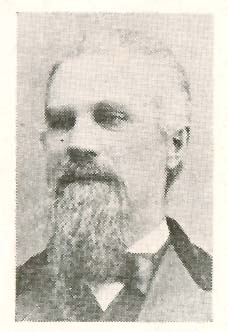
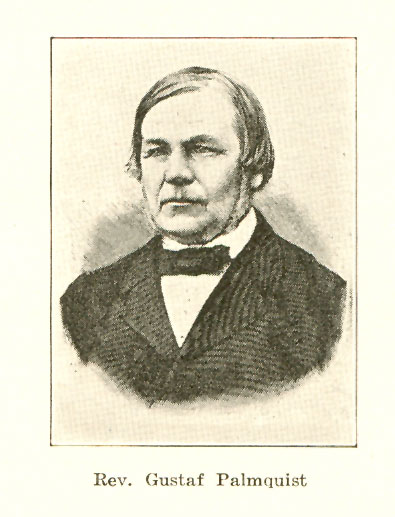
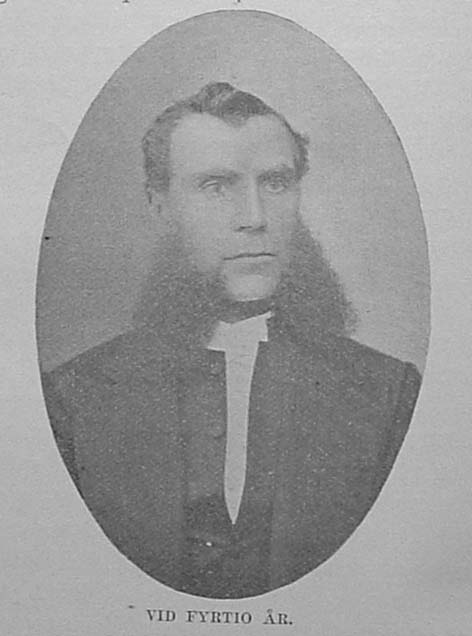
Early on the Chicago scene: L.L Frisk, G. Palmquist and O. Lindh
The Chicago work appears to be a mission field for the more established early centers on the Mississippi, and Gustaf Palmquist upon arriving in America finds friends associating with the Methodists in Chicago; later he visits there from Rock Island. A. Wiberg also looks up Methodist Pastor Newman on his trip through Chicago and is assisted on his way.
Swedish Baptist historian, Adolph Olson remembers:
"The Swedish colony in Chicago -- originally practically all the Swedes were located on the north side bounded on the north by Division street, on the south by Indiana street, on the east by Wells street, and on the west by the river -- had grown into several thousand members." (p. 94)
O. Lindh, whose memoirs are a rich resource, joined in the series of visitors to Chicago Swedish Baptists, but still no enduring congregation could be established. "...they had no church building or meeting place, they had no preacher, and they were all very poor. Furthermore, the Danish Baptist church did not seem to encourage the organization of a Swedish church but suggested that the Swedes join them."
Finally on August 19, 1866, Lindh is joined by N.E. Axling, John Ring and J.H. Ullmark and they effect a formal organization of the First Swedish Baptist church of Chicago in the North Star Baptist church on Division street. Early meeting places for the congregation of 38 include the North Star church, the Danish church, and a Presbyterian school house on Bremer street.
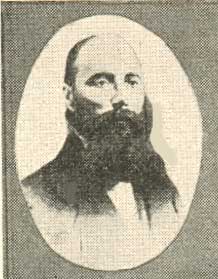
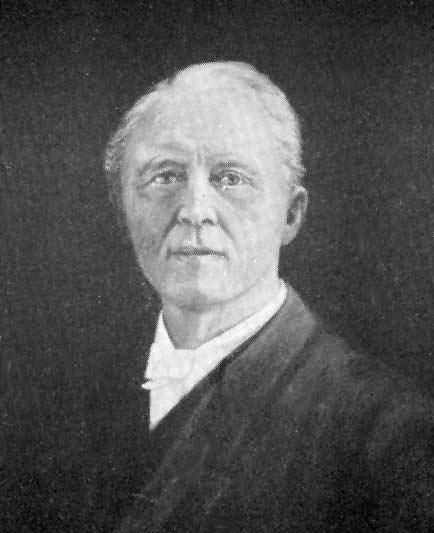
Swedetown Baptist Pastors John Ring and Seminary founder, John Edgren
J. Ring is later found in Oakland, Nebraska, where he is also engaged as a jeweler. Axling also is active on the Nebraska field. A church is built in 1868, with a reported seating capacity of 700, #4 on our map. We regret having found as yet no pictures of this church. It falls victim to the Chicago fire in '71, but is rebuilt on a somewhat smaller scale on the same site during the brief ministry of John Edgren. Edgren has his ambitious plans for a publication and school interrupted at the Oak street location. Though the church is rebuilt, a better opportunity presents itself for establishing a school on the south side in cooperation with the old University of Chicago in the area of the Second Swedish Baptist congregation. With the migration to the strong Milton & Elm and Addison Street Baptist congregations to the north, the old colony congregation seems to fade. What the effects of the Moody Church are we can only speculate, but Swedish Baptists are known to be drawn to this group...their 50th anniversary festival is held at Moody's. Subsequent ministers at old First Swedish Baptist included John Ongman, P.A. Hjelm and G.A. Hagstrom; its peak membership was in 1898, with 695 listed.
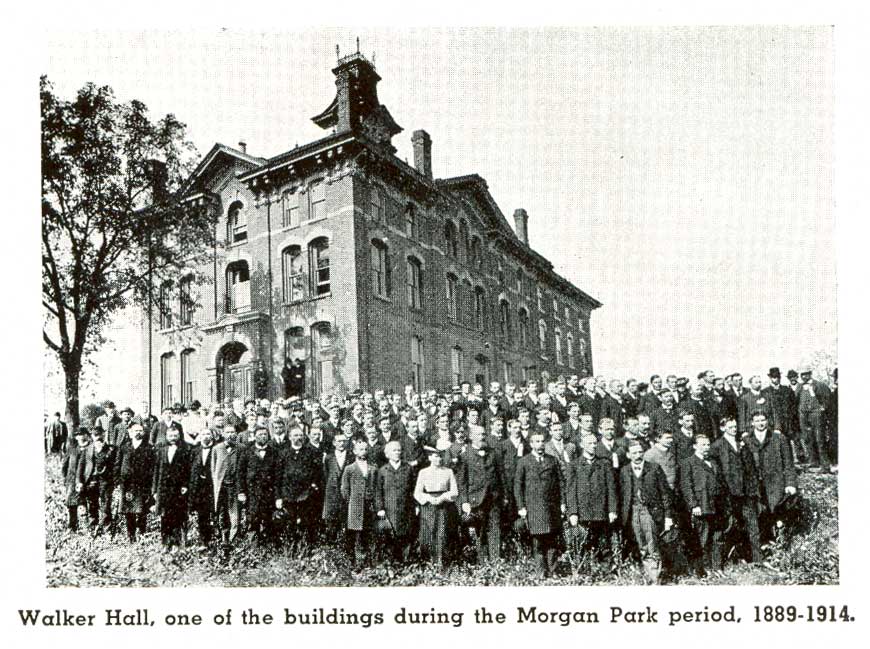
The Swedish Baptist Seminary at Morgan Park, just back from
several years sojourn in Stromsburg, Nebraska
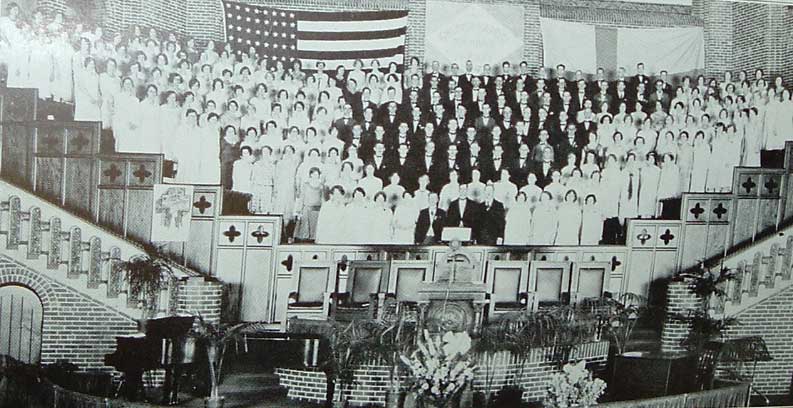
The Swedish Baptists celebrate 50 years at Moody church
* * *
THE MISSION SOCIETY / CHURCH
But another kind of fire is smoldering and about to break out at Immanuel. Carlsson has steered the vessel in this somewhat crowded harbor between the poles of Unonius' Episcopalians on one hand, and the Methodists, Baptists and Moodyites on the other. Now the very stream of immigrants which has fed and fattened the rolls at Immanuel begins to bring another problem; a breed of revivalist Swede not encountered before.
We will repeat again the notion, "when lightning strikes in Sweden, the thunder is heard in America." More than any single doctrinal notion or individual leader's influence, it seems to be the awakening of the independence of the Swedish Mission church in Sweden that results in the same phenomenon here. Now no longer restricted to societies and colporteurs, the Mission church will ordain its own ministers, celebrate its own sacraments, found its own schools and institutions, on both sides of the Atlantic.
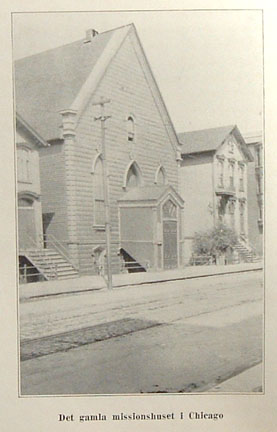
The Franklin Street Missionhus,...or Missionkyrkan?
Unfortunately for the Augustana Synod, it holds the position in America which the now somewhat disenfranchised State church holds in Sweden, at least for the Mission-minded people. And the cane which it has used against the separatists now must be wielded against dissidents among its own members. The Franklin Street Mission society has incorporated and is licensing its own ministers.
The story has been covered many times, and we would point to By One Spirit by Karl Olsson, who had access to the minutes of the Mission Society and whose account would be the gold standard. He reminds us that the new mission society "...did at this time re-emphasize its Lutheran character..." Earlier the Lutheran Cholseth had "...attacked the mission society as Baptist, competitive, and noisy. He criticized Princell for his shouting at the thanksgiving service and for the fact that he spoke in English; he accused the Mission Friends of trying to undermine the Immanuel Church and urged that the new missionshus be used as an immigrant shelter and that the Mission Friends return to the rock from which they were hewn."
The new group has large aspirations. They issue an unsuccessfull call to Oscar Ahnfelt, the premier Swedish hymnwriter, to join their staff; they also invite D.L. Moody to speak at their Thanksgiving service. When C.A. Björk succeeds Sanngren he is joining something that is changing from the mission society models of Jönköping, or even the Swede Bend of his earlier days there. This is a departure from Augustana. Björk is the pivotal character who emerges as the leader of the Mission Synod chartered in 1873 and the Swedish Covenant in 1885, always headquartered at the Swedetown Mission church.
In E.W. Olson's The Swedish Element in Illinois we find it reported; "...the movement began to attract the attention of the synodical pastors, who endeavored to prevent a separation by assuming a friendly attitude." But on the pages of Augustana's "Hemlandet" the Chicago mission group was characterized as "unLutheran, unchurchly and unChristian". The report goes on that the mission group sends John Peterson and Hedenschoug to the Augustana annual meeting in Princeton, Illinois, to call for a retraction. Another source describes this delegation as simply seeking cooperation from the Synod. In any case, there is still a thread of connectedness evidenced on both sides.

Rev. Carl Evald succeeds Erland Carlsson at Immanuel
"Let us go unto the Lord's house"
We would add but two vignettes: the first from an anniversary reminiscence by Rev. Carl Evald of Immanuel:
Anniversary History of the Rev. Erland Carlsson Years Immanuel Lutheran Church of Chicago by Dr. Carl A. Evald, exerpts -Spiritual outpourings of 1857-1858-1870
"At these services no artificial means what-so-ever are used, but each evening a sermon is first preached in the church auditorium by the pastor or his assistant, after which several hundred assemble in the basement chapel, where a brief meditation is conducted by the preacher who has not yet spoken. Thereupon the deacons and other spiritual men give brief exhortations, interspersed with singing and prayer, basing their remarks on some passage of scripture. When this second service is ended it often happens that a third and fourth will follow. These latter services are of a more private nature, a smaller or larger number remaining for consultation or prayer with the pastor or other Christians. From these moments many a one counts the beginning of a life of faith in Jesus Christ, the Son of God."
He adds that the constant communion with God, in a right use of the means of grace the year round, is the soil from which such special services with their blessed experiences spring forth. "...would that God might lead us back to the faith and consecration of former years."
observations on these paragraphs we made years ago:
-note the phrase "artificial means"...does this mean the emotionalism of revival style evangelism?
-and the phrase "or other Christians"...how much of this series of services was in deference to the ordained clergy, in order to "get to the level" where the lay leaders could "have their say?"
-the phrase "the beginning of a life of faith"...(not baptism??)
-the phrase "the soil from which"...a wistful reference to sacramental worship.
To these thoughts we might add that the meetings described above are suggestive of the "after meetings" of the revivalists...
As a mother about to give birth experiences curious discomforts, Immanuel was distended and distressed by the mission revivalists about to form their own fellowship. The graciousness of this account is remarkable in that none of the negative sentiments often associated with this "birth" are cited.
Here is another vignette from C.V. Bowman's history of the Missionfriends:
In the month of July, 1869, the missionary association held the first general "mission meeting" or conference, which seems to have been the first of the kind held in America. The Lutheran church was kindly opened for the services. The mission meeting was advertised widely in the Swedish newspapers. As a result many who were interested in the Mission Friend movement assembled, not only from Chicago but also from Princeton, Galesburg, Rockford and several other places in Illinois. The following ministers were present: C.A. Björk of Swede Bend, Iowa; P. Undeen of Rockford, Ill.; and John Peterson of Geneseo, Ill. The following pastors of the Augustana Synod were also present: A. Hult, G. Peters, and Erland Carlson, the pastor of the Lutheran church in Chicago.
Sessions were held for the discussion of theological problems pertaining to repentance, faith and the works of Jesus Christ for the salvation of mankind... One of the Lutheran pastors had asked that the following question be placed on the program: 'Having among our Swedish people so many pastors and churches and the Word of God proclaimed by word and pen, how then can you prove the need of the Swedish Evangelical Lutheran Missionary Association of Chicago?' The leaders of the association understood the object of the question and formulated the following counter-question: 'What is the cause of the spiritual death so prevalent among our Swedish people though we have both pastors and churches?' Both questions were printed together on the program.
These questions clearly indicated the existing tension between the leaders of the Lutheran church and the leaders of the new Mission Friend movement. This tension was also visible during the prolonged and sharp discussion that took place during the conference. The Mission Friends fearlessly attacked the prevalent spiritual condition of the Lutheran churches and their unscriptural form of organization. In the heat of the discussion not all of them were able to observe the amenities of debate. Consequently some unpleasant remarks were made against the Lutheran pastors, who on the other hand managed to keep their composure well."
It is in this last bit of candid admission by Bowman that we have an almost unique confession from a Mission Friend source.

C.A. Björk, Patriarch of the Mission Friends
We have some remembrances of the young C.V. Bowman concerning the Franklin Street Mission church, 1879:(he speaks of himself as "Kalle")
"Then came the first Sunday in Chicago. Uncle and Aunt, who were Mission Friends, attended the old Mission house which was then on North Franklin Street. It was as clear as sunlight that the newcomer would go with them to church; about this they did not ask his opinion, nor was that necessary. C.A. Björk, now long-since departed, was pastor of the church, but was away that Sunday, and editor A. Hallner preached in his place. Hallner had thinning hair, a sparse, reddish full beard and a somwhat husky voice. Neither the sermon nor the service made any noteworthy impression on Kalle, but this is not to say that they were not good. Ahnfelt's songs, so rich in content, were sung, and the service was Swedish through and through, which pleasantly affected the boy. But in the announcements strange phrases crept in again and again. Kalle wondered what it could mean that the Young Men's Society would meet 'downstairs i basementet' and that the Sewing Society would meet at 'Mrs. Johnsons på Wesson Street, backstairs at the toppen,' but most of the people understood what was said, and it was the newcomer's duty to learn what he did not yet know.
The wooden church building had been erected in 1871 immediately after the Chicago fire. In the basement were some small rooms and a living space where a little book business was carried on by Julin and Hedenschoug. The auditorium which seated perhaps 600 people, had a little balcony across the rear. Across the front was a platform two or three steps high for the pulpit, choir, and organ."
"Sunday after Sunday great crowds of Swedes gathered in the Franklin Street church to hear the Word of life, until at last it became so crowded that the congregation was forced to build a new house of worship. The old church became a synagogue, then it was sold to a black congregation, and finally, after more than half a century, the building was torn down and a garage constructed on the site."
The new church was built one block to the the northwest, and in spite of its historic significance we can not find a single picture of this northside church! (later this would be rectified: see "walking tour") For more than a decade it was ground zero for the Mission Synod, organized in 1873 at Keokuk, Iowa. Its pastor, C.A. Björk was president of the Synod and its successor, the Swedish Mission Covenant. It saw the travail of the Waldenströmian controversy, and the debates over church structure and creeds. When the Covenant was formed in 1885, it was just beyond the reach of retaining the ancient creeds and the Augsburg Confession dear to Lutherans. It's statement of faith went simply; "We believe in the Holy Scriptures, the Old and New Testament, as the Word of God and the only perfect rule for faith, doctrine and conduct." What missed my attention for many years, and what might have missed the attention of generations of Covenanters, is that the Augsburg Confession begins: "We believe in the Holy Scriptures, the Old and New Testament, as the Word of God and the only perfect rule for faith, doctrine and conduct"! Of course, much more followed, but the primal statement was the same.
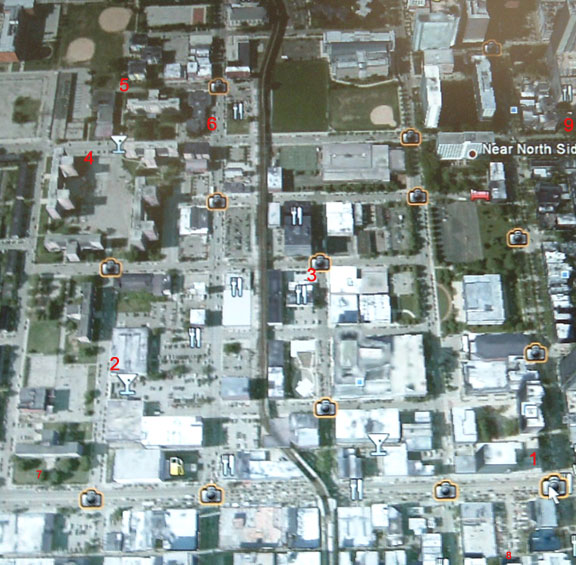
Swedetown from space: the area today with the locations of the churches
Moody bookstore and St. Matthew Methodist the only remaining sites (1) others:
(2) St. Ansgars (3) Mission (4) Baptist (5) Immanuel (6) Methodist
The Chicago "El" train line running from top to bottom through the center of this view carried us countless times through Swedetown, and we never knew it! Six blocks east of the Moody site is the Chicago Water Tower. It would not be hard to find.
Number #9 on the map indicates Oak street to the eastward. There we will be tracing the Oak Street Free Mission and Chicago-Bladet offices, but also down this street were the offices of "Missionswännen", the privately owned organ of the Mission Synod and Covenant group.
The early editor, A. Hallner, tells of his experiences at Missionswännen:
"When I became editor of Missions-wannen the second time, 1885, Chicago-Bladet and Minneapolis Veckobladet, as the paper was called then, had the whole field. Chicago-Bladet was carried by the mighty pen of Princell and his still mightier confidence, and Minneapolis Veckoblad was carried by Pastor Skogsbergh's great and general popularity. I had to squeeze in between these two. The first three years I gained 1,000 subscribers per year, 1888- five thousand in three months, and after that about a thousand a year, so that when I had to leave because of illness and weakness in 1894, the paper had a circulation of 20,000 and Lilla Missionaren had 28,000." (Hallner's unpublished biography)
He is disapproving of his successor's revamping of the paper in the more political and polemic style of Chicago-Bladet, observing that it lost subscribers as a result. The influence of the Swedish church press is hard to overestimate in the era when many homes counted only a Bible and Sears Roebuck catalog as reading material. Evidence of this has turned up in our own family, and if you would like to read two "letters to the editors" to Missionswännen from our great-grandfather, click here.